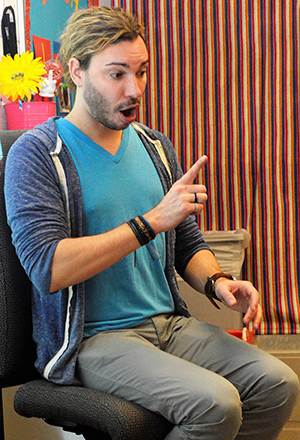
Early on a Monday morning, Kari Chapin’s kindergartners sit on the floor as she leads them through lively exercises — singing the days of the week, counting the date with pennies — then announces they’ll soon have their 100th day of kindergarten. “Can we have 100 bags of popcorn?” one pupil pipes up.
Cruz Ellwood also has something to say. He gestures in sign language to Clinton McMurray, an interpreter for Cruz and three other students in Chapin’s class at West Oakview Elementary School who are deaf or hard of hearing.
‘Reaching Every Child: What’s New in Special Education’ is an ongoing series on special education in Kent County.
| ‘It’s Part of Who We Are’
Northview Public Schools’ Total Communication program serves 63 students who are deaf or hard of hearing (D/HH), at all grade levels and from throughout Kent ISD. The approach helps students access language through both speech and signing, and employs 20 interpreters. Another program, the Grand Rapids Oral Deaf Program at Ken-O-Sha Elementary, uses an auditory/oral approach in which students develop listening skills without sign language. From as early as infancy, the programs help children learn the language other students take for granted, and grasp the subjects embedded in that language. At Northview, one of the state’s largest programs, 95 percent of the D/HH students have interpreters in their K-12 classes – sometimes even for a single student. The D/HH students are well-integrated with the general student population and add value to it, says Northview Supervisor Trish Lopucki: “It’s been so ingrained in our culture, that now it’s part of who we are.” |
“At church, he ate 100 things, like cupcakes and turkey,” McMurray says on Cruz’s behalf. This pleases the other students, who otherwise would have no idea of the boy’s fun Sunday meal.
McMurray is Cruz’s voice to Chapin, and hers to Cruz, as well as his conduit for the other kindergartners. Whether interpreting for them as she reads a story, playing basketball with them in gym or helping the art teacher with an activity, he is their indispensable link.
As one of 20 interpreters for Northview Public Schools’ 63 students with a hearing challenge, it’s a role he takes seriously.
“We really are their window to information, to the world around them, in terms of language,” says McMurray, in his 14th year as an interpreter for Northview Public Schools. “We take on more roles than just interpreting. We’re mentors, we’re parental figures. We are often the only language models that they might have.”
Invaluable Partners to Teachers
McMurray’s sign-language skills are crucial to teachers like Chapin. She considers him her teaching partner.
“He is invaluable to me,” says Chapin. “He is the line of communication” for the students. “He truly cares about those kids and their success,” Chapin says.
Also helping West Oakview students succeed are resource teachers and a speech pathologist.
A Zeeland High School graduate, McMurray initially studied dance in college but switched to interpreting. He’d always enjoyed foreign language and was fascinated by American Sign Language in particular. He graduated in 2004 from Lansing Community College’s American Sign Language (ASL) program and was hired by Northview a month later.
“I fell in love with working with kids, and being able to be a bridge for them,” McMurray says. “Over the years, to see their light bulbs go on is incredibly satisfying.”

Learning in Many Forms
He is certified to interpret in both elementary and secondary schools and has experience in many grade levels at Northview. McMurray uses both ASL to communicate concepts for the teacher, but also finger-spelling, especially at the lower elementary level.
For students learning to spell, they need to both understand the meaning of the word and the letters that form it so they can recognize it in print, he explains. Plus, since there are no ASL signs for proper names, words like “Henry” must be spelled out.
He also aims to convey “incidental learning” – things that other students routinely overhear. For instance, he may point out a child coughing, so the student knows why others are looking in the child’s direction. That way, the student learns their coughing can bother others.

So can interrupting the teacher’s lesson, which his students can do silently by signing to him. He may sign to tell them to stop talking, or sometimes speak the words aloud, earning a reprimand from the teacher.
“I want them to learn that’s inappropriate behavior, just like hearing kids learn,” McMurray says. “They should be treated the same as other kids.”
On this morning, however, there are no reprimands – just the obvious joy he takes in his job. He enthusiastically signs with animated facial expressions, whether it’s the pledge of allegiance, reading a story about penguins or doing happy body exercises.
“I love working with them,” McMurray says. “They make me feel young, and make me feel satisfied with my job.”
CONNECT
SNN Story: ‘A Model Program,’ Says State Superintendent
















